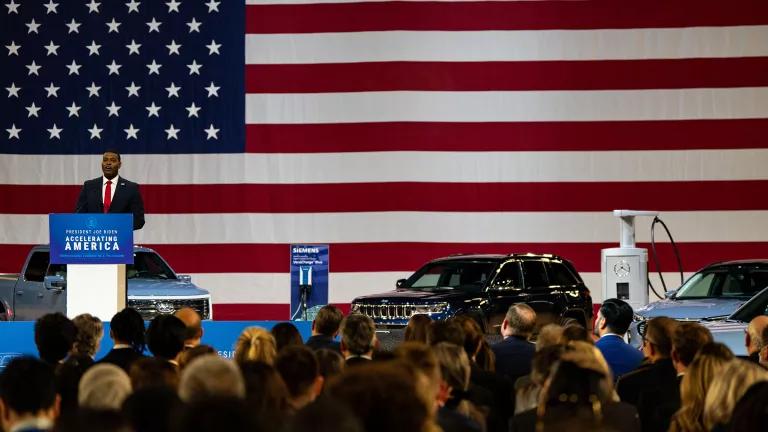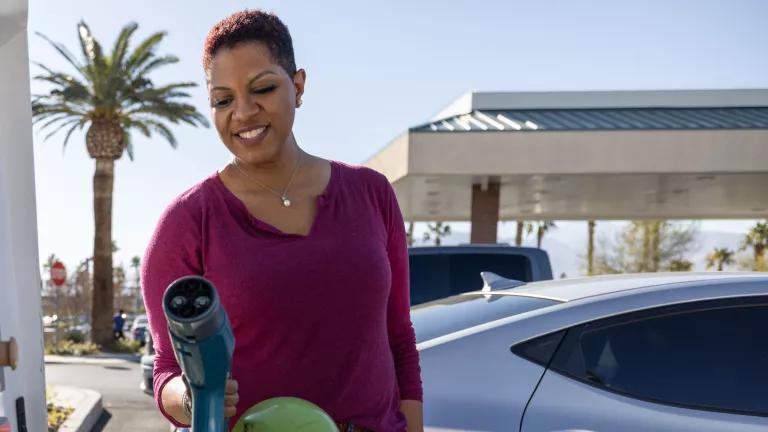The California Air Resources Board (ARB) released a soup-to-nuts review of its Advanced Clean Car (ACC) program today. The 658-page report confirms that the popular program, which establishes smog-forming and carbon pollution limits for new cars and trucks, can be met on time, with known technologies, and at reasonable cost. Agency-experts recommend that the Board stay the course on the standards, pointing to a large body of evidence showing the auto industry is already exceeding standards and are on-track to meet 2025 targets.
What It Means
Should the Board agree with staff’s recommendations at the hearing in March and redouble its commitment to current standards, it would mean that the new fleet of cars and trucks would get cleaner over time. By 2025, new vehicles would emit 75% less smog-forming pollutants and nearly 50% less greenhouse gas emissions versus those produced just five years ago. California, home to six of the ten most polluted cities in the country, would continue to see improvements to public health with the program helping avoid thousands of asthma attacks, emergency room visits, and premature deaths attributed to vehicle emissions.
According to the staff, the standards have also brought a bevy of more fuel-efficient cars and trucks to showrooms. In fact, in just six years automakers have introduced over 25 new electric-drive models with those numbers expected to grow to 70 models over the next five years. Consumers are also benefiting from significant fuel savings. On average, a household with a vehicle meeting the 2025 standards would save on average $4000 compared to a new vehicle today, with fuel savings exceeding the additional cost of the technology. Many households that finance or lease vehicles these days would start seeing net savings in the first month of ownership.
ARB’s findings are consistent with EPA’s recent determination that their national version of California’s standards should remain strong [see my colleague Luke Tonachel’s blog here]. Both technical reviews come on the heels of last summer’s draft “Technical Assessment Report” conducted by the U.S. Environmental Protection Agency (EPA), the National Highway Traffic Safety Administration and the California Air Resources Board. Together with a recent National Research Council report showing standards can be met at reasonable costs, the preponderance of technical evidence supports maintaining standards.
On the Menu: Strengthening of the Zero Emission Vehicle Program, Albeit Delayed
ARB’s report also pointed to strengthening the Zero Emission Vehicle program while also tuning-up its overly generous crediting system, but not within the 2022 to 2025 time-frame and instead, as part of future standards starting in 2026. This past July, NRDC released a consultant report that found automakers could readily meet the “Zero Emission Vehicle” requirements with much lower sales volume of electric vehicles than originally anticipated. Similarly, ARB’s new analysis—using updated technical assumptions—found automakers would only need about 8% sales by 2025 of ZEVs and plug-in hybrids rather the 15% sales originally anticipated, resulting in about 1.1 to 1.2 million vehicles rather than the 1.5 million state target. Agency staff has flagged potentially modifying the compliance credit system—albeit in 2026 rather than 2022 as we had recommended—to better align ZEV requirements to actual vehicle sales.
California Reaffirms Continued Support of the National Program, but Warns Against Weakening
California—as part of the National Program Agreement between the state, EPA, and automakers—allowed automakers to comply with California standards by meeting federal standards. With an eye towards anti-regulatory forces in D.C. seeking to potentially weaken federal standards, California signaled its right and obligation to revisit whether the state could still meet its unique air quality challenges and aggressive state greenhouse gas reduction goals under “substantially modified”—as in weakened—federal standards.
A collision course with states—obligated to protect public health and address carbon pollution—could begin if national clean car standards are weakened. But there’s no need for a collision if agencies and automakers maintain the current course to meet existing standards. Ultimately, playing bumper cars with pollution standards gets everyone nowhere fast—and may leave the industry with a bad case of whiplash.




